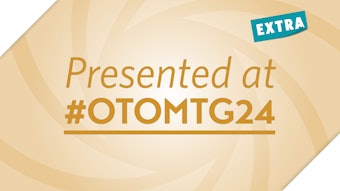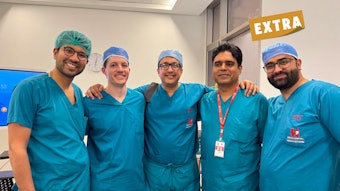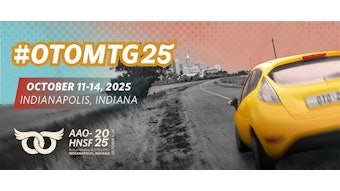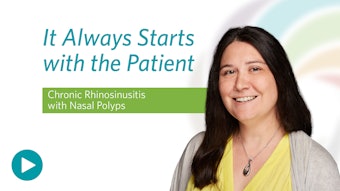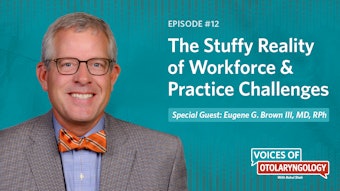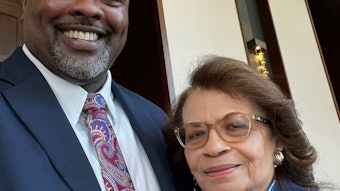Ethics in Practice: Finding Breathing Room
In the latest installment of this series, the AAO-HNS/F Ethics Committee delves into the ethical challenges of tracheostomies for otolaryngologists.
Megan Gillespie, MD, and Tabitha L. Galloway, MD, on behalf of the Ethics Committee
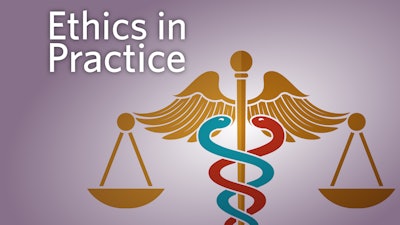
Tracheostomies in the Intensive Care Unit
The intensive care unit (ICU) is one of the most common settings for tracheostomy consultation, with as many as one-third of ICU patients requiring a tracheostomy.1 The decision to proceed with a tracheostomy is as ethically nuanced as each patient's circumstances.
Timing for tracheostomy consultations
One of the first ethical quandaries otolaryngologists face is determining the timing threshold for accepting tracheostomy consultations. Tracheostomies are recommended once the need for prolonged intubation is determined, as defined by mechanical ventilation longer than 14 days. Many consultations are requested before that 14-day mark because the duration of intubation correlates with increased incidences of long-term complications like glottic stenosis and granulomas.2,3 Some studies also suggest that performing earlier tracheostomies shortens ventilator use, ICU, and overall hospital durations.4 Consequently, surgeons are frequently encouraged to pursue tracheostomies earlier as opposed to later. However, clinicians often struggle to accurately predict which patients will require prolonged mechanical ventilation.5
Is it unethical to refuse tracheostomy consultations until patients have been allowed more time to be weaned from ventilation or pass extubation trials, knowing that the longer the intubation duration, the greater the chance of intubation-associated complications? The answer depends on the delicate balance of beneficence and non-maleficence among both otolaryngologists and critical care specialists. On one hand, beneficence necessitates that these patients undergo tracheostomies for their respective indications, whereas non-maleficence requires that tracheostomies are not unnecessarily performed on patients who may have otherwise avoided the risks and sequelae.
Prognosis and futility
When the prognosis is poor, there is a tension between preserving life and avoiding futile care that prolongs suffering—especially suffering not directly witnessed by otolaryngologists and ICU physicians after patients transfer to long-term care facilities. The ethics literature suggests at least a moderate degree of certainty that a tracheostomy is not medically futile before proceeding because it makes it harder for patients to die painlessly or spontaneously.6 But, a “moderate” degree of certainty is difficult to define. One objective measure is calculating ProVent scores to predict the one-year mortality of patients receiving prolonged mechanical ventilation.7 Even with this score, it is difficult to incorporate the calculated weight of tracheostomy’s quality of life benefits, such as phonation, oral feeding, and decreased sedation. When do these benefits outweigh the futility of a tracheostomy?
For example, a patient underwent a tracheostomy for terminal anaplastic thyroid carcinoma in hopes of improved alertness and communication with their family. Although the procedure was successful, they only lived for two weeks and never left the hospital owing to tracheostomy care. Was the procedure futile? Or did it provide a quality-of-life benefit that cannot be measured by surgeons?
Elucidating patient values and goals
This is where the patient’s values, goals, and preferences come into play. Rarely do ICU patients have the decisional capacity to delineate these directly. Depending on state laws, it falls to family members, friends, or any person at the bedside. Medical surrogates have the relentless task of honoring patient’s wishes, minimizing suffering, and holding onto hope. They face the agonizing dilemma of knowing when to continue life-sustaining treatment and when continuing care merely prolongs the dying process. Otolaryngologists must help elucidate this by not merely discussing procedural risks/benefits/alternatives but by reviewing the personal implications - how tracheostomies impact communication, caregiver requirements, discharge disposition, cosmetic appearance, reintegration into society, and long-term trajectories. One of the best starting questions is, “What are you hoping this tracheostomy will help them achieve?”. This provides the surgeon with the surrogate’s insight, corrects misinterpretations about tracheostomies, and initiates an approachable discussion about the real-world challenges of tracheostomies beyond sterile, medical facts.
Post-tracheostomy care
Even after the above ethical dilemmas are navigated, the questions of post-tracheostomy care, supply coordination, and follow-up persist. Care is frequently re-diverted to the primary care team after tracheostomies. However, approximately one-quarter of non-otolaryngology providers at tertiary academic centers score beneath the 70th percentile on tracheostomy care exams.8 It subsequently falls to otolaryngologists to determine continuous, reliable, and coordinated tracheostomy care.
Patients lacking insurance coverage or support systems add an additional layer of complexity that threatens the ethical principle of justice. Case managers are a core piece of the solution, but otolaryngologists have the responsibility of ensuring education through hands-on training, tracheostomy clinics, or telemedicine visits. Some institutions have expanded their efforts by providing tracheostomy care education to ICU and hospital staff.8
Emergency Settings
Tracheostomies in emergency settings pose distinct ethical challenges from those performed in the ICU.
Time constraints and informed consent
Tracheostomy decision-making and consent are inherently complex and nuanced. There is often no time for a detailed discussion in emergency settings. When faced with an immediate threat, emergent tracheostomies may be performed expeditiously without full patient or family consultation, relying instead on the principles of beneficence and implied consent.
In cases where the procedure is urgent but not immediately lifesaving, obtaining efficient—yet empathetic—consent is crucial. A challenge in these scenarios is the lack of general anesthesia, which further heightens patient anxiety and impairs rational decision-making.
Otolaryngologists must provide clear, realistic information about the procedure, as well as emotional support throughout the pre- and intra-operative periods. Striking this balance is essential to ensure patients and families feel informed and supported despite the distressing nature of the situation.
Autonomy Versus Nonmaleficence
Beyond obtaining consent, clinicians navigate the ethical tension between patient autonomy and nonmaleficence. It is not uncommon for patients with obstructive airway masses to refuse elective tracheostomies—stating they will only consent once acute respiratory distress ensues. Patient autonomy must be upheld. However, delaying tracheostomies until an acute crisis increases the likelihood of airway loss and mortality. Even if the airway is secured, emergent tracheostomies have 3.33 times more complications than elective tracheostomies.9 Delaying also places additional strain on surrogate decision-makers, healthcare resources, and healthcare personnel.
How can otolaryngologists effectively balance patient autonomy and non-maleficence in these situations? One of the first steps is engaging in an honest but not intimidating discussion on why an elective tracheostomy is being refused. Is it due to fear, denial, lack of perceived urgency, or incongruence with end-of-life goals? Shaping the discussion around this incongruence can then enable effective shared decision-making.
When patients remain steadfast in their refusal, periodic reassessments are required because their views may evolve with disease progression or worsening symptoms. Telemedicine may facilitate these discussions when patients are physically restricted. Establishing advance directives or documenting patient preferences regarding emergency airway intervention can also help guide future decision-making.
Ultimately, while the physician must respect patient autonomy, it is equally their responsibility to ensure that refusal is based on a fully informed understanding of the risks. By fostering open, ongoing dialogue, otolaryngologists can encourage patients to make choices that align with their values and minimize the potential for preventable harm.
Conclusions
Tracheostomies are intertwined with ethical complexities that extend beyond clinical knowledge. Whether in the ICU, emergency settings, or post-procedural care, these decisions demand nuanced discussions incorporating prognosis, patient values, and realistic expectations—led by the core concepts of beneficence, non-maleficence, autonomy, and justice. By fostering communication and proactive education, otolaryngologists can ensure these decisions are made with both clinical expertise and ethical integrity.
References
- Casserly P, Lang E, Fenton JE, Walsh M. Assessment of healthcare professionals’ knowledge of managing emergency complications in patients with a tracheostomy. British Journal of Anaesthesia. 2007;99(3):380-383. doi:10.1093/bja/aem167
- Whited RE. A prospective study of laryngotracheal sequelae in long‐term intubation. The Laryngoscope. 1984;94(3):367-377. doi:10.1288/00005537-198403000-00014
- McWhorter AJ. Tracheotomy: Timing and techniques. Current Opinion in Otolaryngology & Head and Neck Surgery. 2003;11(6):473-479. doi:10.1097/00020840-200312000-00012
- Rodriguez JL, Steinberg SM, Luchetti FA, Gibbons KJ, Taheri PA, Flint LM. Early tracheostomy for primary airway management in the surgical critical care setting. Journal of British Surgery. 1990;77(12):1406-1410. doi:10.1002/bjs.1800771228
- Nelson J, Carson S, Bice T. To trach or not to trach: Uncertainty in the care of the chronically critically ill. Seminars in Respiratory and Critical Care Medicine. 2015;36(06):851-858. doi:10.1055/s-0035-1564872
- Drubin CW, Frye CC, Brown D, Kopar P. When doctors disagree: A case-based discussion of pro-active ethics. The Journal of Clinical Ethics. 2021;32(1):61-68. doi:10.1086/jce2021321061
- Kim W-Y, Jo E-J, Eom JS, et al. Validation of the prognosis for prolonged ventilation (provent) score in patients receiving 14 days of mechanical ventilation. Journal of Critical Care. 2018;44:249-254. doi:10.1016/j.jcrc.2017.11.029
- Yelverton JC, Nguyen JH, Wan W, Kenerson MC, Schuman TA. Effectiveness of a standardized education process for tracheostomy care. The Laryngoscope. 2014;125(2):342-347. doi:10.1002/lary.24821
- Choudhury AA, Sultana T, Joarder MA, Tarafder KH. A comparative study of elective and emergency tracheostomy. Bangladesh Journal of Otorhinolaryngology. 1970;14(2):57-62. doi:10.3329/bjo.v14i2.3282




